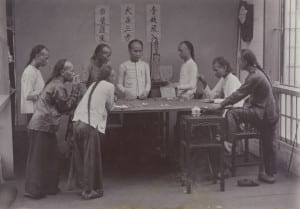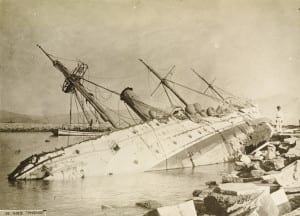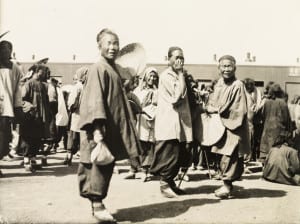Update: Photographs and films in the British Empire and Commonwealth Collection
Posted on by Lauren MacCarthy.
By Nicky Sugar and Jayne Pucknell, archivists at Bristol Archives.
We introduced ourselves last summer as the project archivists working on photographs and films from the former British Empire and Commonwealth Museum. During that time, we’ve made considerable progress getting to know the collections.
We completed an audit of over 900 photographic collections before Christmas. From this, we’ve identified a shortlist of nearly 80 of the most important. As we’re aiming to catalogue about 40 collections during the next 18 months, the challenge now is to select which of those to work on!

Eight men with distinctive Manchu hairstyles play the traditional Chinese gambling game ‘fantan’, c1905 (Marriott collection, ref. 1998/028/1/2/67)

The British naval steamship HMS Phoenix, which was capsized by a typhoon in Kowloon, Hong Kong in September 1906 (Marriott collection, ref. 1998/028/1/1/117)

Chinese women at a station on the Peking to Hankow railway line, c1910 (Marriott collection, ref. 1998/028/1/1/206)
Picking out the most significant has been really hard, which shows how fascinating and unique these collections are. Our shortlist includes examples from nearly every Commonwealth country, dating from the 1860s to the 1970s.
We’ve now catalogued our first five ‘priority’ collections, which will shortly be available online via Bristol museums’ cataloguing system, and we’ll share some links with you in a future blog. These include images and films created by globetrotting photographers (Geoffrey and Yvonne Morey), a missionary and social anthropologist based in West Africa (George Basden), army men who served in India (Colonels Ramsay Weston and Charles Foskett Phipps) and a medical doctor in Hong Kong (Oliver Marriott).
The photographs shown here come from Dr Marriott’s collection. He worked at the Peak Hospital in Hong Kong between 1902 and 1923 and during that time he took and collected photographs of scenes and events around him. He was particularly interested in locals going about their daily business and there are shots of shoe-makers, farmers, street-traders, petty criminals in the stocks and many general street scenes. He also photographed buildings and temples and he was in Hong Kong during a severe typhoon in 1907, so we have images of the damage it caused.
The next step in the project will involve volunteers – we’ve started recruiting students and other volunteers to assist with listing and repackaging. With their help, we would like to extend our cataloguing target and make even more images available online for research by the end of the project. In return, our volunteers will have the opportunity to work with some unique material and find out what it’s like to work in archives.
We’ve also made good progress on the BECC film archive. We’re 95% of the way through an audit of nearly 950 films which have already been digitised. At the same time, we’re creating versions of these films which we plan to make accessible in our public searchroom at some point. The film catalogues will also be revised and published online.
The collection includes some real treasures, such as rare footage of the Imperial Airways four engine bi-plane designed by Handley Page in the 1930s. Only eight of these planes were built and we have film showing two of them, named ‘Hannibal’ and ‘Horsa’, in India. We also have evidence of important events such as the restoration of the Ashanti Confederacy in 1935 in West Africa, filmed by eye-witness Sir Francis Jackson. This records the coronation of the Ashantihene or Kings of Kings. Jackson was Chief Commissioner of the Gold Coast at that time and took part in the celebrations.
Footage from the film collection is already in demand: clips from several films were used in a recent BBC documentary about Rudyard Kipling.
After these early months of planning, we’re reaching the really exciting part of the project – really getting to know the photographs and films! We’re looking forward to introducing these collections in our next blog post.
If you are interested in volunteering with Bristol Archives or any of our other sites, please contact us.
With thanks to
These catalogues are being produced with support from the National Cataloguing Grants Programme for Archives.